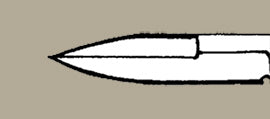Learn About Survival Knife Blade Types
When choosing a survival knife, it's important to understand the pros and cons of various blade shapes. Some blade shapes are more suited for combat, while others will be much more useful if you're stuck in the wilderness.
Our main purpose at Survival Knife Experts is to help you be prepared for wilderness survival situations, so I'll share my opinions with you about the best blade shape for that situation.
Avoid Double-Edged Spear Point blades
 A true spear-point blade has two sharpened edges--one on the top and one on the bottom. However, some blades are called spear points that have a similar shape, while actually having only a single sharpened edge. These single-edged "spear point" blades are not what I'm talking about here.
A true spear-point blade has two sharpened edges--one on the top and one on the bottom. However, some blades are called spear points that have a similar shape, while actually having only a single sharpened edge. These single-edged "spear point" blades are not what I'm talking about here.
Double-edged spear point blades are more suited for a combat situation than wilderness survival, in my opinion, since they are designed to be good for stabbing.
Why should you avoid a double-edged spear point? Well, having a sharp edge on the top of your blade can be a disadvantage in a survival situation. For one thing, a sharpened top edge can make batoning next to impossible, which is often a vital use of a survival knife.
Quick Tip: Batoning is a technique for cutting or splitting wood using a knife. It involves placing your knife against the wood, then striking the back of the knife with a baton (usually a wooden stick). This is a handy way to cut wood that would otherwise require a hatchet or axe.
For another thing, you'll often hold your thumb against the back edge of your blade for leverage and control while using your knife in a survival situation (for things like delicate carving or dressing small game), and having a sharp edge on the top of your blade can make using your thumb in this way dangerous or impossible.
Summary: A double-edged spear point blade is not a good choice for a survival knife. However, a single-edged "spear point" blade is fine.
Tanto blades as survival knives
 Tantos are technically fighting knives, but they are much better suited to a survival situation than a double-edged spear point blade. Tantos are generally thick and strong to the tip, which makes them good for stabbing and piercing. The strong tip also makes them suitable for prying.
Tantos are technically fighting knives, but they are much better suited to a survival situation than a double-edged spear point blade. Tantos are generally thick and strong to the tip, which makes them good for stabbing and piercing. The strong tip also makes them suitable for prying.
Tantos do not have a belly (curved edge), which makes them less useful for slicing and skinning game.
In my opinion, tantos are a good option as survival knives, but it really comes down to what you like and what you find most useful.
Summary: A tanto blade is a good survival knife, depending on your preferences.
What about Bowie (Clip Point) survival knives?
 There are mixed opinions on the subject of whether or not clip point knives (commonly referred to as Bowie knives) make good survival knives. The truth is that there are pros and cons, and that it's really up to you.
There are mixed opinions on the subject of whether or not clip point knives (commonly referred to as Bowie knives) make good survival knives. The truth is that there are pros and cons, and that it's really up to you.
If you do go with a Bowie survival knife, just make sure that the clip point is not too drastic (too much of a curvy tip, that is). An especially curvy tip can break more easily when being used for batoning or other tasks that involve prying or chopping. The curvy tip is designed for stabbing, so keep that in mind.
The curve of the blade can be useful for skinning game.
Summary: A Bowie (clip point) blade is a good survival knife--just don't get a blade with an extremely curvy tip or it will be susceptible to breaking under impact.
Drop point blades (my favorite survival knife blade)
 All things considered, drop point blades are the most versatile and useful in a wilderness survival situation. A drop point blade has a straight back edge, which is perfect for batoning. It has a strong, sharp tip, useful for stabbing, prying, delicate carving, notching, and many other tasks you'll face in a wilderness survival situation.
All things considered, drop point blades are the most versatile and useful in a wilderness survival situation. A drop point blade has a straight back edge, which is perfect for batoning. It has a strong, sharp tip, useful for stabbing, prying, delicate carving, notching, and many other tasks you'll face in a wilderness survival situation.

